Project Serbia
AN IMPORTANT INITIATIVE OF ”NATIONAL REVIEW” AND SCULPTOR OSTOJA BALKANSKI
The Path of Serbian Glory
The workshop of the famous artist already includes about 250 completed excellent reliefs-portraits of great people of Serbian history and culture, from Stefan Nemanja to Patriarch Pavle. Upon the suggestion of National Review, the artist will grant this to the Serbian people as a starting point for establishing a unique cultural and historical open air gallery. How? A nice stone path should be made through the woods in Avala. On each fifth meter of the path, one relief-portrait should be placed on a pedestal made of Ljig sandstone, with the name and basic information. The further additions to the path would be managed by a special authoritative body of the SANU, and new reliefs-portraits would be created by the most famous Serbian artists in a special sculptors’ colony. The Path of Serbian Glory would turn Avala into a real Olympus of Serbian history and culture and one of the most attractive places in the cultural, historical and tourism offer of the Serbian capital
By: Bane Velimirović
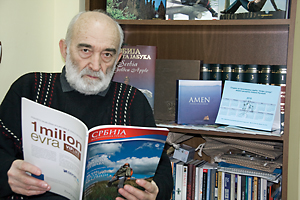 The life story of Ostoja Balkanski (Ostoja of the Balkans), academic sculptor, is long and unusual. How else would it be? As Ršumović would say: The life story of Ostoja Balkanski (Ostoja of the Balkans), academic sculptor, is long and unusual. How else would it be? As Ršumović would say:
”The gift writes the fate,
There has never been a mistake in this.
There are many those ”of the Balkans”,
But only one is Ostoja.”
He was born in 1937, in Lipnički Šor, in Jadar, ”somewhere in the Balkans”. He graduated from high school of applied arts in Niš in 1958, and from the Faculty of Applied Arts (sculpture) in Belgrade in 1964. Simply and directly related to the origins, the origins of the human and origins of art, he did not hesitate to dive into the adventure of the world with his step, his eye and all-seeing fingers. Immediately after graduation, he was already on a dist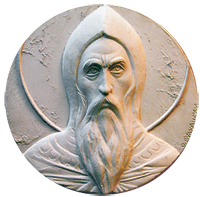 ant road. He set off to the world, to travel and create. And he continued the journey for more than 20 years, returned briefly and then departed again, until 1985. (”Discovering the world is the same as discovering one’s own life and fate”, he says.) However, Ostoja did not set off to Paris, Rome or America, as one would expect from an artist. ant road. He set off to the world, to travel and create. And he continued the journey for more than 20 years, returned briefly and then departed again, until 1985. (”Discovering the world is the same as discovering one’s own life and fate”, he says.) However, Ostoja did not set off to Paris, Rome or America, as one would expect from an artist.
– It was a time of liberation of many African and Asian nations from centuries-long colonialism, when new states were created, unknown to me. The second day after I had graduated in June 1964, I left by hitchhiking over Bulgaria and Turkey to Syria, Lebanon, Jordan and Cyprus. That is how I started discovering the world, admiring what I see and experience. My life was enriched with new landscapes, cultural and historical monuments and people. I was astonished by the past of the nations I was meeting, their life, customs, art, religion, tradition. I returned two months later, full 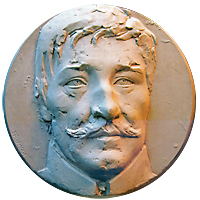 of impressions and with a load of drawings. This first journey made me dedicate a big part of my creative work to nations and countries which were members of the Non-Aligned Movement together with our country – remembers Ostoja Balkanski. – Following the invitation of the Syrian Ministry of Culture in 1970, I traveled with my wife by car to the opening of the exhibition in the National Museum in Damascus… Already in 1971, I was granted a six-month scholarship of the Sudan government for advanced processing of ivory and ebony. At the end of my stay, I organized an exhibition in Khartoum ”Impressions from Sudan”, where I also exhibited my portrait of the country’s president Nimeiri… of impressions and with a load of drawings. This first journey made me dedicate a big part of my creative work to nations and countries which were members of the Non-Aligned Movement together with our country – remembers Ostoja Balkanski. – Following the invitation of the Syrian Ministry of Culture in 1970, I traveled with my wife by car to the opening of the exhibition in the National Museum in Damascus… Already in 1971, I was granted a six-month scholarship of the Sudan government for advanced processing of ivory and ebony. At the end of my stay, I organized an exhibition in Khartoum ”Impressions from Sudan”, where I also exhibited my portrait of the country’s president Nimeiri…
It was the first portrait of a state leader he made. Afterwards he portrayed Nehru and Indira Gandhi (India), Makarios (Cyprus), Suharto (Indonesia), Nasser and Sadat (Egypt), Kaundu (Zambia), Njerere (Tanzania), Sirimavo Bandaranaike (Sri Lanka), Fi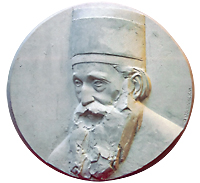 del Castro (Cuba), Hussein (Jordan), Mugabe (Zimbabwe), Gaddafi (Libya), Saddam Hussein (Iraq), Norodom Sihanouk (Cambodia)... Kings, presidents, prime ministers. The crucial protagonists of their countries’ history. With some of them he became close, a friend. He stayed at the best hotel chains in the world, had apartments in them, personal drivers, security. del Castro (Cuba), Hussein (Jordan), Mugabe (Zimbabwe), Gaddafi (Libya), Saddam Hussein (Iraq), Norodom Sihanouk (Cambodia)... Kings, presidents, prime ministers. The crucial protagonists of their countries’ history. With some of them he became close, a friend. He stayed at the best hotel chains in the world, had apartments in them, personal drivers, security.
However, this man of the Balkans was always more interested in artistic communication on the level of archetype and primordial, on the level of pre-ideas (which precedes literacy and our understanding of culture).
– I have exhibited in places where people have never heard of an art painting or electricity, in African villages far from modern civilization and communications. In order to get to know better that world and my new friends, I tried to live as they do: in houses made of savannah grass, without doors or windows – tells Ostoja and there, before us, goes through bunches of old photographs and pages of his exciting books where he described a part of this (Studio Whole World, Belgrade, 2003).
Among larger exhibitions in all five continents, we will mention those in Sudan (Khartoum, 1972), Nigeria (Lagos, 1978), Libya (Tripoli, 1979), Guinea (Koukoutamba, 1979), Iraq (Bagdad, 1980), Sri Lanka (Colombo, 1980), Australia (Melbourne, 1983)...
SCULPTED SERBIAN HISTORY
However, the greatest inspiration of Ostoja of the Balkans, through all those decades, his primary stimulation and incurable passion was the history of his own, Serbian nation. In the circle of ancestors, contemporaries and offspring, he felt the power of the vow and debt, his personal debt and the debt of his generation to those who were here before and to those who will come.
By sculpting the faces of crucial protagonists, all those high foreheads and piercing eyes, all those moustaches and smiles, he sought the secret in the nucleus of this history and this culture, its foundation and top, the pre-idea from which it originates and reflects. Educators, warriors, monarchs, commanders, poets, scientists, saints, philosophers, tribunes, visionaries, martyrs, workers, peasants, hayduks, writers, architects, businessmen, benefactors. Balkanski created reliefs, portraits, busts, monuments, medals, plaques. He exhibited in Belgrade (1970, 1978, 1979, 1987, 1995, 1998), Šabac (1970), Niš (1989), Orašac (2004). He created monuments in Crna Bara, Krasava, Voćnjak, Lipnički Šor, Draginje, monument to the soldiers from 1992-1995 u Šamac, Republic of Srpska. He made 69 reliefs-portraits of dukes from the First and Second Serbian Uprising for the Serbian Museum of History, and reliefs-portraits of St. Sava which he granted to schools which carry the name of the saint in Belgrade, Zvornik and Lipnički Šor. The busts of people from Serbian history he created are in Lešnica, Erdevik, Mačvanski Pričinović, Orovica, Srb, Petrinja, Brankovina, Ljubotinje, Gornja Trnava, Tekeriš.
In his book Gift to the Nation (Belgrade, 2005), the artist enclosed a precise list of 185 sculptures he created and gifted throughout Serbian lands.
Ostoja Balkanski sculpted the whole Serbian history, heroic, martyr-like, orthodox, ascended the national to the omni-human and universal. He eternalized it in stone and bronze. In materials which will outlive even the grandsons of our grandsons. It can be compared only with the way the famous Vjačeslav Klikov sculpted the Russian history.
In the workshop of this master today, there are about 250 completed reliefs-portraits of great Serbian people from Stefan Nemanja to Patriarch Pavle. Upon the initiative of National Review, the great sculptor is ready to grant the whole collection to the Serbian nation as a gift.
– I suggest we establish the Path of Serbian Glory, unique open air gallery somewhere, perhaps best on Avala – says the artist. – How? A nice stone path through the woods should be made in Avala. On each, let’s say fifth meter, one relief-portrait should be placed on a pedestal made of beautiful yet inexpensive sandstone from Ljig. It would state the name, year of birth and death, and what the person was in the history of Serbia. Each pedestal and the path would be lit at night. All this could be done with lots of cost saving and would not be too much of a financial burden. Already now I know about thirty people who would donate material, each for 5-10 monuments, I would give the reliefs-portraits, and a lot could be done if many, both companies and individuals, would work together.
NEW BELGRADE ATTRACTION
The Path of Serbian Glory would turn Avala into a true Olympus of Serbian history and culture. It would certainly soon become one of the most attractive elements of the cultural, historical and tourism offer of the Serbian capital. Tens of thousands of schoolchildren who come to excursions to Belgrade would visit the National Museum (if some righteous people release it from slavery and open it again one day), the Fortress, Church of St. Sava, and on Avala they would visit the Tower, Monument to the Unknown Hero and Path of Serbian Glory. Belgrade schools would hold some of their classes in nature there, on the Path of Serbian Glory. Numerous cultural programs, competitions, family excursions would also be directed there. Each of us, whenever hopes become illusive, whenever we think that we have lost our idea and our way, when what makes us a nation among nations becomes dimmed, could drive to Avala, and have a light, recuperating stroll down the Path of Serbian Glory.
The Path would also undoubtedly be interesting for foreigners, members of other nations, races and cultures, for tourists, those in transit or those who are temporarily living and working here. On the beautiful mountain, in an attractive location, in nature, during a pleasant walk, they would get to know the most important facts about the history and culture of the host country: about its best people. (The walk could also be accompanied with a small publication which would include more details about the great people on the Path of Serbian Glory in several world languages.)
And just like history neither begins nor ends with us, the Path of Serbian Glory should not be considered completed.
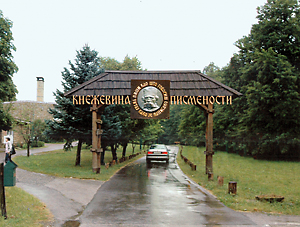 – Perhaps it would be best to form a corresponding authoritative body in the Serbian Academy of Sciences and Arts, which would include high officials of the Serbian Orthodox Church, the state, reputable scientific and art societies – Ostoja Balkanski develops the idea further. – Each five or ten years, this body would decide about whose reliefs-portraits should be added to the Path of Serbian Glory. Then famous Serbian artists would be invited to the sculptors’ colony in Avala to create reliefs-portraits of the newly included in the Path. Each of them would give his or her work as a gift to the Serbian nation. The ones selected as the best or most convenient would be placed on the Path, and others could be gifted to other cities and museums all over the Serbian lands, even the Diaspora. Each pedestal would have a discrete signature of the author of the relief-portrait, as well as the name of the material donator. The same body would agree on the list of great people whose portraits are already completed and which would be a starting point for the Path. If it concludes that someone else should be added, this would be done in the meantime. – Perhaps it would be best to form a corresponding authoritative body in the Serbian Academy of Sciences and Arts, which would include high officials of the Serbian Orthodox Church, the state, reputable scientific and art societies – Ostoja Balkanski develops the idea further. – Each five or ten years, this body would decide about whose reliefs-portraits should be added to the Path of Serbian Glory. Then famous Serbian artists would be invited to the sculptors’ colony in Avala to create reliefs-portraits of the newly included in the Path. Each of them would give his or her work as a gift to the Serbian nation. The ones selected as the best or most convenient would be placed on the Path, and others could be gifted to other cities and museums all over the Serbian lands, even the Diaspora. Each pedestal would have a discrete signature of the author of the relief-portrait, as well as the name of the material donator. The same body would agree on the list of great people whose portraits are already completed and which would be a starting point for the Path. If it concludes that someone else should be added, this would be done in the meantime.
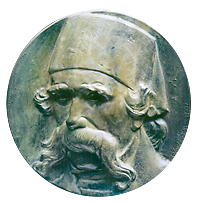 And so, time would pass by, and the Path of Serbian Glory would continue winding through the Avala woods, getting longer and longer. And so, time would pass by, and the Path of Serbian Glory would continue winding through the Avala woods, getting longer and longer.
Does this idea have any shortcomings?
Is it to the common benefit and joy?
Does it provoke pettiness and low feelings in us, or goodness, righteousness, and pride?
Is it expensive and hard to implement? Does it cost more than any average political party member puts in his or her pocket in the first year of his or her mandate in the municipality?
Could anything else except our weakness and shortsightedness prevent us from implementing it?
All right, then it is your turn now, yours personally. We are waiting for you to join!
***
Free from Politics
One more thing: there must not be any party politics in this, and it would be strictly determined by foundation documents and rules of behavior! No ceremonial openings in election campaigns, no pictures of party leaders who forced a few of their managing directors to donate money. This must be clean and general, it should unite, not separate, or it should not be made at all. Whoever wants to participate in this for some banal personal gain and not because he feels it in his heart, should not participate at all.
***
Vuk
Ostoja Balkanski dedicated a significant part of his creative work to Vuk Karadžić and his achievements. He exhibited in Tršić, Vuk’s birth village, in 1966, 1972, 1976, 1980, 1987, 1998. He has created the up to now undoubtedly best concept of revitalization of the famous Tršić ethno-cultural area, but it was never implemented because this is obviously incomprehensible for people who decide about it locally. Balkanski created monuments of Vuk Karadžić in Plocki (Poland) and Sarajevo. He designed the Ordain of Vuk Karadžić for the competition announced by the Federal Government. He also created the life-size figure of Vuk and numerous busts, reliefs and plaques presenting him. He is also author of the book Vuk and His Contemporaries.
|
